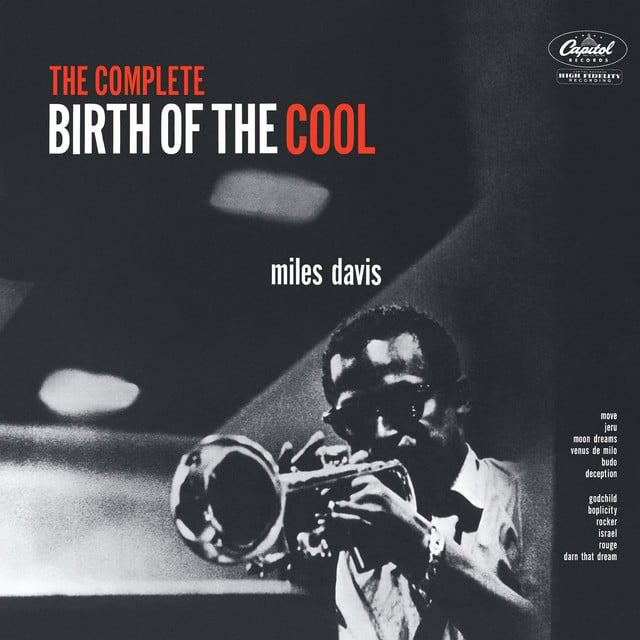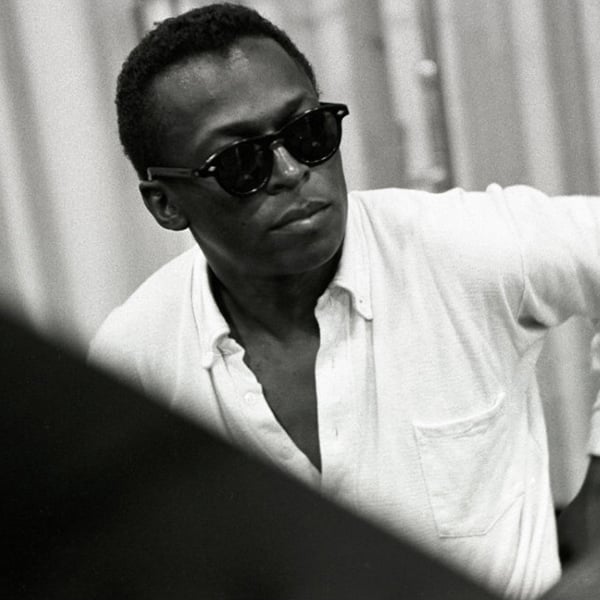
Miles Davis’ first truly influential project as a leader—which produced a series of recordings between 1949 and 1951 that helped shift the course of improvised music—was publicly underappreciated for almost ten years. In fact, Birth of the Cool, the title by which these tracks are now collectively known, was not applied until 1957 when Capitol Records collected the original eleven 78rpm sides and reissued them as a cohesive LP.
Birth of the Cool was the most important stylistic step to follow after bebop—generating an entirely new wave of playing that influenced a new generation in the early 1950s. It started as a way of finding a way to meld the polyphony and other modern classical ideas (discordance, impressionism, unusual instrumentation) with the harmonic licenses pioneered by Charlie Parker and Dizzy Gillespie. Its reserved, emotional affect was its most recognized aspect: a laid-back reprieve from the unfettered frenetic energy of bebop that seemed a perfect fit for the insouciant, dark-sunglasses-at-midnight spirit that was shared by the likes of Chet Baker, Gerry Mulligan, Stan Getz and other purveyors of the Cool jazz sound.
Birth of the Cool was born in a series of rehearsals that began in 1947 in a small basement apartment on 55th Street: Miles was in charge, leading a crew of like-minded musicians. The musicians who popped in and out of that basement band represented the cream of the next generation of jazz modernists: Davis’ old friends George Russell and John Lewis, Lee Konitz, Kai Winding, Mike Zwerin, Al Haig, Max Roach, Gunther Schuller, Al McKibbon and many others. Some—like Mulligan and Konitz—had been in a big band led by pianist Claude Thornhill who had developed a unique sound that drew generously from 20th Century classical textures and colors. The apartment was rented by arranger Gil Evans, another Thornhill alumni, who helped give shape to the music.
The nine-man group they finally settled on was a reduced version of the jazz-band-cum-orchestra-brass Thornhill model: trumpet, trombone, French horn, tuba, alto saxophone, baritone saxophone, piano, bass and drums. “We wanted that sound but . . . as small as possible, “ Davis noted, adding: “I looked at the group like it was a choir . . . I wanted the instruments to sound like human voices.”
Most importantly, this “composer conclave” (as Russell described it) ultimately afforded the young trumpeter the first opportunity to spread his wings as band leader and to take an initial, calculated step towards a more relaxed, reduced sound. At first, Davis was “unsure of how to be boss” recalls trombonist/writer Mike Zwerin. “He relied quite a bit on Evans to give musical instructions to the players.” But soon he had “cracked the whip” and “dominated the band completely,” according to Mulligan.
In September 1948, the marquee went up at the Royal Roost – one of Manhattan’s leading jazz haunts at Broadway and 47th Street – to announce the band’s first engagement, supporting Count Basie. Their residency lasted two weeks. It played only one other gig and disbanded the next year, but not before waxing 12 recordings for Capitol Records in early 1949 and 1950.
With Miles name as the leader on the record label, the music was released over the next few years as a series of influential—but not best-selling—78s. Their initial impact was relegated to jazz critics and musicians. But before the 1950’s had passed, the critical world looked upon the Birth of the Cool sessions as a musical shift of seismic proportions in jazz. One critic hailed the nonet’s music as summarizing “the whole achievement of modern jazz up to that point.” Writer Martin Williams, in an overview of all jazz achievements of the ‘50s, hailed its influence (“the effect of melodic rhythm on phrasing and on percussion”) and its role in launching an ascending star (“the promise of maturity in Davis himself, particularly in those splendid solos in ‘Move’ and ‘Israel’.”)
It had been a bold effort for the young trumpeter, and one that came with a price. While planning the nonet recordings, Davis had received the call of a lifetime: the opportunity to join the Duke Ellington Orchestra, arguably the jazz world’s most established and respected outfit. Miles still recalled being blown away: “[Duke] tells me I’m in his plans for the fall [of 1948], musically speaking, and he wants me in his band. Man that knocked me right out . . . But I had to tell him that I couldn’t make it, because I was finishing up The Birth of the Cool.” (Auto., p.121)
It is nothing less than astonishing to consider that even at 22, Davis had the presence of mind and sense of commitment to turn down the security and stature-raising of a seat in Duke’s band.




























